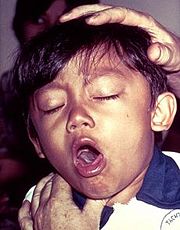Pertussis Toxin-ATP Complex
From Proteopedia
(Difference between revisions)
| Line 1: | Line 1: | ||
| - | + | <StructureSection load=1bcp size='500' side='right' caption='Pertussis Toxin-ATP complex ([[1bcp]])' scene=''>[[Image:230px-Pertussis.jpg|left|thumb|A young boy coughing due to pertussis.]] | |
| - | <StructureSection load=1bcp size='500' side='right' caption='Pertussis Toxin-ATP complex | + | |
| - | + | ||
==introduction== | ==introduction== | ||
'''Protussis Toxins''' is a major virulence factor of ''Bordetella pertussis'' that cause whooping cough. Whooping cough, also known as pertusis, is a highly contagious bacterial disease caused by the bacteria ''Bordetella pertussis''. This disease had been characterized by severe cough that has been documented to cause subconjunctival hemorrhages, rib fractures, hernias, fainting and vertebral artery dissection. The pertussis toxin has been characterized as being a AB toxin meaning that there are 2 subunits: A subunit possesses the enzyme activity and the B subunit it the receptor binding portion. Together this AB toxin colonizes the respiratory tract and becomes activated by destabilization due to the binding of ATP. | '''Protussis Toxins''' is a major virulence factor of ''Bordetella pertussis'' that cause whooping cough. Whooping cough, also known as pertusis, is a highly contagious bacterial disease caused by the bacteria ''Bordetella pertussis''. This disease had been characterized by severe cough that has been documented to cause subconjunctival hemorrhages, rib fractures, hernias, fainting and vertebral artery dissection. The pertussis toxin has been characterized as being a AB toxin meaning that there are 2 subunits: A subunit possesses the enzyme activity and the B subunit it the receptor binding portion. Together this AB toxin colonizes the respiratory tract and becomes activated by destabilization due to the binding of ATP. | ||
==structure== | ==structure== | ||
| - | The protussis toxin is a AB5 toxin consisting of a six-component protein complex. With that in mind, this protein is a hexamer containing a catalytic (S1) subunit that is tightly associated with the pentameric cell-binding component (B-oligomer). | + | The protussis toxin is a AB5 toxin consisting of a six-component protein complex. With that in mind, this protein is a hexamer containing a catalytic (S1) subunit that is tightly associated with the pentameric cell-binding component (B-oligomer). The S1 component is a single subunit <scene name='Pertussis_Toxin-ATP_Complex/Subunit_1/3'>S1 (chains A,G)</scene> while the B-oligomer is a pentamer composed of four types of subunits: <scene name='Pertussis_Toxin-ATP_Complex/Subunit_2/2'>S2 (chains B,H)</scene>, <scene name='Pertussis_Toxin-ATP_Complex/Subunit_3/2'>S3 (chainsC,I)</scene>, two copies of <scene name='Pertussis_Toxin-ATP_Complex/Subunit_4/2'>S4 (chains D,E,J,K)</scene>, and <scene name='Pertussis_Toxin-ATP_Complex/Subunit_5/3'>S5 (chains F,L)</scene>.<ref name=Hazes>PMID: 8637000</ref> This B subnit is what binds to the terminal sialic acid residues. |
==Pertussis Toxin activation== | ==Pertussis Toxin activation== | ||
| Line 16: | Line 14: | ||
==Conclusion== | ==Conclusion== | ||
This paper was significant since it gave a clear understanding of the PT activation as well as a better understanding to the pathogenesis of the toxin. (talk about this more and clarify) | This paper was significant since it gave a clear understanding of the PT activation as well as a better understanding to the pathogenesis of the toxin. (talk about this more and clarify) | ||
| + | |||
| + | </StructureSection> | ||
==References== | ==References== | ||
| - | + | <references/> | |
Revision as of 10:01, 9 November 2011
| |||||||||||
References
- ↑ Hazes B, Boodhoo A, Cockle SA, Read RJ. Crystal structure of the pertussis toxin-ATP complex: a molecular sensor. J Mol Biol. 1996 May 17;258(4):661-71. PMID:8637000 doi:10.1006/jmbi.1996.0277

